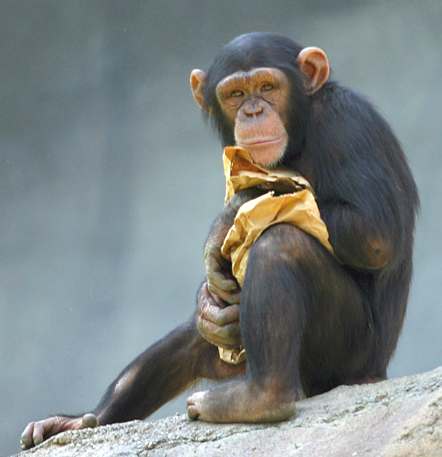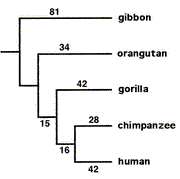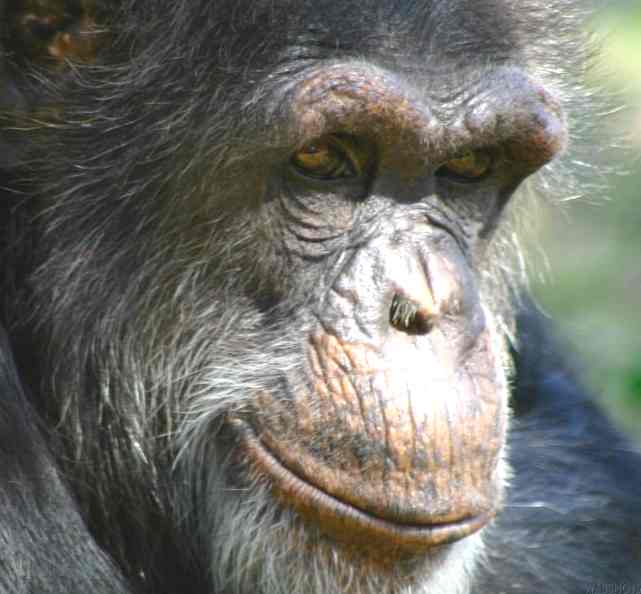|
CHIMPANZEE
|
|||||||||||||||||||||||||||||||||||||||||||||||||||
|
HOME | BIOLOGY | FILMS | GEOGRAPHY | HISTORY | INDEX | MUSIC | SOLAR BOATS | SPORT | SPONSORS |
|||||||||||||||||||||||||||||||||||||||||||||||||||
|
Who has not laughed at the antics of these close relatives. Chimpanzees, often shortened to chimp, is the common name for the two extant species in the genus Pan. The better known chimpanzee is Pan troglodytes, the Common Chimpanzee, living in West and Central Africa. Its cousin, the Bonobo or "Pygmy Chimpanzee" as it is known archaically, Pan paniscus, is found in the forests of the Democratic Republic of the Congo. The boundary between the two species is formed by the Congo River.
Nelson Kruschandl - "I'm related"
Measurements
A full grown adult male chimpanzee can weigh from 35-70 kg (75-155 pounds) and stand 0.9-1.2 m (3-4 ft) tall, while usually females weigh 26-50 kg (57-110 pounds) and stand 0.66-1 m (2-3.5 ft) tall.
Lifespan
Chimpanzees rarely live past the age of 40 in the wild, but have been known to reach the age of 60 in captivity, although Tarzan star Cheeta is still alive as of 2006 at the age of 74.
Chimpanzee differences
Anatomical differences between Common and Pygmy Chimpanzees are slight, but in sexual and social behaviour there are marked differences. Common Chimpanzees have an omnivorous diet, a troop hunting culture based on beta males led by a relatively weak alpha, and highly complex social relationships; Bonobos, on the other hand, have a mostly herbivorous diet and an egalitarian, matriarchal, sexually promiscuous culture. The exposed skin of the face, hands and feet varies from pink to very dark in both species, but is generally lighter in younger individuals, darkening as maturity is reached. Bonobos have longer arms and tend to walk upright much of the time.
History of human interaction
Although Africans have had contact with chimpanzees for millennia, the first recorded (Western) contact of humans with chimps was made by Europeans scouting Angola at some point during the 1600s. The diary of Portuguese explorer Duarte Pacheco Pereira (1506), preserved in the Portuguese National Archive (Torre do Tombo), is probably the first European document to acknowledge that chimpanzees built their own rudimentary tools.
The first use of the name "chimpanzee", however, did not occur until 1738. The name is derived from a Tshiluba language term "kivili-chimpenze", which is the local name for the animal and translates loosely as "mockman" or possibly just "ape". The colloquialism "chimp" was most likely coined some time in the late 1870s. Science would eventually take the 'pan' occurring in 'chimpanzee' and attribute it to Pan, a rural ancient Greek god of nature. Biologists would apply Pan as the genus name of the animal. Chimps as well as other apes had also been purported to have existed in ancient times, but did so mainly as myths and legends on the edge of Euro-Arabic societal consciousness, mainly through fragmented and sketchy accounts of European adventurers. Apes are mentioned variously by Aristotle, as well as the Bible.
When chimpanzees first began arriving on the European continent, European scientists noted the inaccuracy of these ancient descriptions, which often falsely reported that chimpanzees had horns and hooves. The first of these early trans-continental chimpanzees came from Angola and were presented as a gift to the Prince of Orange in 1640, and were followed by a few of its brethren over the next several years. Scientists who examined these rare specimens were baffled, and described these first chimpanzees as "pygmies", and noted the animals' distinct similarities to humans. The next two decades would see a number of the creatures imported into Europe, mainly acquired by various zoological gardens as entertainment for visitors.
Darwin's theory of evolution (published in 1859) spurred scientific interest in chimpanzees, as in much of life science, leading eventually to numerous studies of the animals in the wild and captivity. The observers of chimpanzees at the time were mainly interested in behaviour as it related to that of humans. This was less strictly and disinterestedly scientific than it might sound, with much attention being focused on whether or not the animals had traits that could be considered 'good'; the intelligence of chimpanzees was often significantly exaggerated. At one point there was even a scheme drawn up to domesticate chimpanzees in order to have them perform various menial tasks (i.e. factory work). By the end of the 1800s chimpanzees remained very much a mystery to humans, with very little factual scientific information available.
The 20th century saw a new age of scientific research into chimpanzee behaviour. Prior to 1960, almost nothing was known about chimpanzee behavior in their natural habitat. In July of that year, Jane Goodall set out to Tanzania's Gombe forest to live among the chimpanzees. Her discovery of chimpanzees making and using tools was groundbreaking, as it had previously been believed that humans were the only species to do so. The most progressive earlier studies on chimpanzees were spearheaded primarily by Wolfgang Köhler and Robert Yerkes, both of whom were renowned psychologists. Both men and their colleagues established laboratory studies of chimpanzees focused specifically on learning about the intellectual, particularly the problem-solving, abilities of chimpanzees. This typically involved basic, practical tests on laboratory chimpanzees, which required a fairly high intellectual capacity (such as how to solve the problem of reaching an out-of-reach banana). Notably, Yerkes also made extensive observations of chimpanzees in the wild which added tremendously to the scientific understanding of chimpanzees and their behaviour. Yerkes studied chimpanzees until World War II, while Köhler concluded five years of study and published his famous Mentality of Apes in 1925 (which is coincidentally when Yerkes began his analyses), eventually concluding that "chimpanzees manifest intelligent behavior of the general kind familiar in human beings ... a type of behaviour which counts as specifically human" (1925).
Common Chimpanzees have been known to attack humans, there have been several documented attacks. There have been many attacks in Uganda by chimpanzees against human children; the results are usually fatal for the children. This is largely due to the fact that chimpanzees mistake human children for the Western Red Colobus: one of their favorite meals. The dangers of careless human interactions with chimpanzees are only aggravated by the fact that many chimpanzees perceive humans as potential rivals, and by the fact that the average chimpanzee has over 5 times the upper-body strength of a human male. As a result virtually any angered chimpanzee can easily overpower and potentially kill even a fully grown man, as shown by the attack and near death of former NASCAR driver Saint James Davis. Some African tribes hunt Bonobos for bush meat as a cheap source of food. This has led to a serious decline in the Bonobo population.
Basic facts
Common Chimpanzees are found in the tropical forests and wet savannas of Western and Central Africa. They used to inhabit most of this region, but their habitat has been dramatically reduced in recent years.
Adults in the wild weigh between 40 and 65 kg (88 and 143 lb); males can measure up to 160 cm (63 inches) and females to 130 cm (51 inches), and although lighter than humans they have a pull 5-6 times stronger [1]. This is because the muscles of chimpanzees and other primates are far more effective than those of humans[2]. Their bodies are covered by a coarse dark brown hair, except for the face, fingers, toes, palms of the hands and soles of the feet. Both their thumbs and their big toes are opposable, allowing a precision grip. Their gestation period is 8 months. Infants are weaned when they are about 3 years old, but usually maintain a close relationship with their mother for several more years; they reach puberty at the age of 8-10, and their lifespan in captivity is about 50 years.
Although omnivores, their diet is mainly vegetarian, consisting of fruits, leaves, nuts, seeds, tubers, and miscellaneous plantlife supplemented by insects and small prey. There are also instances of organized hunting; in some cases, such as the killing of leopard cubs, this seems to be primarily a protective effort. However, Common Chimpanzees sometimes band together and hunt Western Red Colobus monkeys (Piliocolobus badius) for their meat. Isolated cases of cannibalism have been documented. Chimpanzees have also been known on rare occasions to attack and eat human infants.
The ape clade. Chimpanzees are the closest living relatives to humans. The numbers in this diagram provide an estimate of relatedness based on similarities in proteins between the various apes
Social behavior
Common Chimpanzees live in communities that typically range from 20 to more than 150 members, but spend most of their time traveling in small parties of just a few individuals. They are both arboreal and terrestrial, spending equal time in the trees and on the ground. Their habitual gait is quadrupedal, using the soles of their feet and resting on their knuckles, but they can walk upright for short distances.
The Common Chimpanzee lives in a fission-fusion society, where mating is promiscuous, and may be found in groups of the following types: all-male, adult females and offspring, bisexual, one female and her offspring, or a single individual. The core of the societies are males who roam around, protecting members of the group as well as engaging in the search for food. Among males, there is generally a dominance hierarchy. However, this unusual fission-fusion social structure, "in which portions of the parent group may on a regular basis separate from and then rejoin the rest", is highly variable in terms of which particular individual chimpanzees congregate at a given time. This is mainly due to chimpanzees having a high level of individual autonomy within the fission-fusion society. Also, communities have large ranges that overlap with those of other groups.
As a result, individual chimpanzees often forage for food alone, or in smaller groups (as opposed to the much larger parent group, which encompasses all the chimpanzees who regularly come into contact and congregate into parties in a particular area). As stated, these smaller groups also emerge in a variety of types, for a variety of purposes. For example, an all-male troop may be organized in order to hunt for meat, while a bi-sexual group consisting of one mature male and one mature female may occur for the purposes of copulation. An individual may encounter certain individuals quite frequently, but have run-ins with others almost never or only in large-scale gatherings. Due to the varying frequency at which chimpanzees associate, the structure of their societies is highly complicated. Chimpanzee Genome Project
Human and Common Chimpanzee DNA is very similar. After the completion of the Human genome project, a Common Chimpanzee Genome Project was initiated. In December of 2003, a preliminary analysis of 7600 genes shared between the two genomes confirmed that certain genes such as the forkhead-box P2 transcription factor, which is involved in speech development, have undergone rapid evolution in the human lineage. A draft version of the chimpanzee genome was published on September 1, 2005, in an article produced by the Chimpanzee Sequencing and Analysis Consortium. The DNA sequence differences between humans and chimpanzees is about thirty-five million single-nucleotide changes, five million insertion/deletion events, and various chromosomal rearrangements.
Typical human and chimp homologs of proteins differ in only an average of two amino acids. About 30% of all human proteins are identical in sequence to the corresponding chimp protein. Duplications of small parts of chromosomes have been the major source of differences between human and chimp genetic material, with about 2.7% of the genome now representing differences having been produced by gene duplications or deletions during approximately 6 million years since humans and chimps diverged from their common evolutionary ancestor. Results from the human and chimp genome analyses should help in understanding the genetic basis of some human diseases.
Chimpanzee male
Diet
Fruit, leaves, flowers, seeds, insects, and small animal prey. Feeding is usually an individual activity but they can work co-operatively to hunt larger prey such as monkeys, pigs, and antelope.
Reproduction
Female chimpanzees are usually 13-15 years old before they have their first off-spring. Usually a single baby is born after an eight-month pregnancy, though twins have been documented in the wild. Infants are weaned when they are about 3 years old but usually maintain a close relationship with their mother for several more years.
Life Cycle
Chimpanzees reach sexual maturity at around 11-13 years of age. The average life span is 53 years.
Interesting Facts :
Taxonomic relationships
The genus Pan is now considered to be part of the subfamily Homininae to which humans also belong. Biologists believe that the two species of chimpanzees are the closest living evolutionary relatives to humans. It is thought that humans shared a common ancestor with chimpanzees and gorillas as recently as four to seven million years ago, and that they have about 95 to 99.4 percent of their DNA in common with humans, with at least some of the difference occurring in 'junk' DNA. It has even been proposed that troglodytes and paniscus belong with sapiens in the genus Homo, rather than in Pan. One argument for this is that other species have been reclassified to belong to the same genus on the basis of less genetic similarity than that between humans and chimpanzees.
Indeed cladistic taxonomy, based on both genetic difference and date of likely divergence, is very clear in placing both extant species of Pan in the genus Homo, mainly because the genus Homo takes precedence on account of being coined first. It is very important, however, to consider where the differences in the genome appear. A study published by Clark and Nielsen of Cornell University in the December 2003 issue of the journal Science highlights differences related to one of humankind's defining qualities — the ability to understand language and to communicate through speech, though these macro-phenotypic differences may owe less to physiology than might be assumed given that Homo sapiens developed modern cultural features long after the modern physiological features were in place and indeed competed averagely against other species of Homo with regard to tools, etc for many millennia.
Differences also exist in the genes for smell, in genes that regulate the metabolism of amino acids and in genes that may affect the ability to digest various proteins. See the history of hominoid taxonomy for more about the history of the classification of chimpanzees.
|
|
Antelope Cat - Domestic Dolphin
|
Leopard Water
Buffalo
|
REFERENCE and LINKS:
|
A taste for adventure capitalists
Solar Cola - a healthier alternative
|




